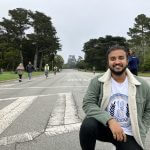What’s holding up promised ‘Quick Build’ street safety projects?
By the end of this summer, people walking on Jones Street in the Tenderloin or Evans Avenue in the Bayview will do so more safely. Both streets have ‘Vision Zero Quick Build’ projects under construction. Safety fixes are being added that will calm traffic and make it safer to cross the street: lane reductions, transit boarding islands to protect riders, daylighting, and painted safety zones.
When the ‘Quick Build’ program launched in 2019, it quickly proved to be one of the City’s most powerful tools for traffic safety. Using paint, posts, signs, and signal changes, Quick Build projects bring safety fixes to life in a matter of months, not years. With about 80 miles of designated ‘high-injury’ streets awaiting safety fixes, Quick Builds are how the City can bridge that gap.
That’s why Walk SF and the Vision Zero Coalition pushed so hard for – and won – a commitment in the City’s new Vision Zero Action Strategy to complete 20 Quick Build projects each year. Soon after that commitment, SFMTA announced the first 10 Quick Build projects for 2022, including dangerous streets like Lake Merced Boulevard, Lincoln Way, and Sutter Street.
But it’s now almost August, and Walk SF is deeply concerned about the SFMTA delivering on 20 Quick Build projects in 2022. In a meeting with SFMTA staff and the Vision Zero Coalition in June, SFMTA staff shared that they have been waiting on an updated map of the high-injury network from the Department of Public Health. SFMTA needs the updated map to have the full picture on what’s happening with the high-injury network in order to know how to prioritize Quick Build projects and roll out the program efficiently.
The high-injury network map, which was first created in 2015 and last updated in 2017, details the 13% of streets where 75% of traffic crashes happen (about 160 miles of streets). It’s an essential tool for addressing traffic safety in a data-based, proactive way – so that improvements go to where they’re most needed. Another update of the map was supposed to happen in 2019, but the pandemic set this back significantly.
Earlier this month, Walk SF and 16 community-based organizations, neighborhood groups, and civic organizations sent a letter to the Department of Public Health demanding that they complete the updated high-injury network map within a month as key to Vision Zero progress. Read the letter.
Without this updated map, the City can’t see where safety improvements have worked in terms of reducing crashes – and also which new streets need attention. And a lot has changed since 2017: there are ten thousand more housing units, the rise of rideshare companies and food delivery, and more.
Our letter got a response late last week, with the Department of Public Health committing to an updated high-injury network map sometime in the fall of 2022. But what if there are more delays? It’s frustrating to have such a key department for Vision Zero unable to prioritize this work – and this needs to change. We need all City departments be actively engaged in Vision Zero and follow through on their commitments.
So Walk SF is calling on the San Francisco County Transportation Authority (SFCTA) Board to hold a hearing with these departments including the Department of Public Health and SF Fire Departments. With 19 people killed in crashes in just the first half of 2022, we need urgency and action across City government.
Are you involved with a neighborhood or community-based group, nonprofit, or civic group that should be part of the Vision Zero Coalition? Contact Brian Haagsman, Advocacy & Policy Manager.
Banner image by Brian Haagsman is of the Williams Avenue ‘Quick Build’ project. This dangerous street got safety fixes including a lane reduction, daylighting, and traffic-calming elements using paint and posts.




